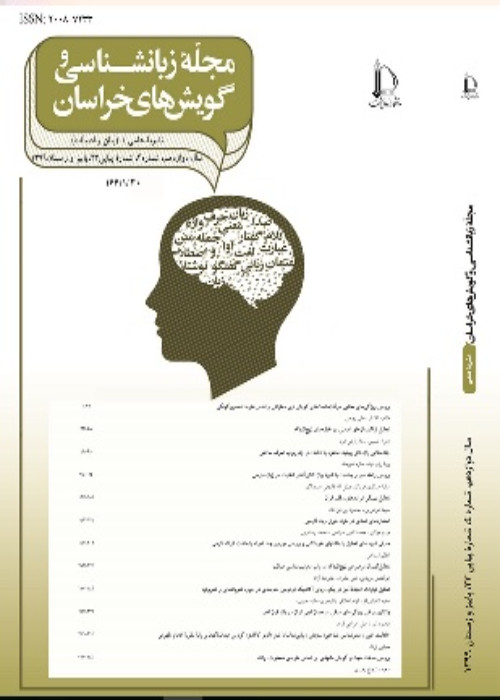Introducing MIP: A Method for Identifying Metaphors in Discourse
Author(s):
Abstract:
Introduction
In the last several years, it has been established that metaphor is not deviant and not any prevalent in rhetoric and in literary writing, but is actually an indispensable part of a natural language and thought. Emerging cognitive linguistics as an approach of looking at both language and thought in recent years, has led to take metaphor in to account as a powerful new way of understanding and expressing abstract imaginations by concrete and perceptible things. Metaphor is here broadly defined as a set of correspondence or a mapping between two conceptual domains, following the central tenet of conceptual metaphor theory (CMT, Lakoff & Johnson, 1980) and discourse is understood as verbal communication in natural situation. Metaphor is cognitive-linguistically defined as a conceptual domain, the source (e.g., WAR) and the target domain (e.g., ARGUMENT). To study metaphor, its functions in sentences, its underlying mappings, its effect on processing and so on, they need to reliably and systematically identify in order to create a solid basis for analysis. To fulfill this, we present the metaphor identification procedure followed by an example of how the procedure can be applied to identify metaphorically words in this text, then we suggest a format for reporting the result of MIP. The result of this study has proved that although using this method for identifying metaphor is not easy at all, but at present MIP is the optimal, authentic, reliable and explicit method for identification metaphor.Methodology
In order to get our aim i.e. identifying and analyzing of metaphor in real texts, I will take a data-based approach. The corpus I work on contains some parts of news articles. In this study I will use MIP as a systematic, explicit and repeatable method for metaphor identification. This method is in fact a response to the vast amount of intuition-based research.Discussion
One of the problems in metaphor research in last years has been identifying and explicating metaphoric language in real discourse. The difficulty with this line of work, however is the metaphor scholars often differ in their intuitions about what constitutes a metaphoric word or phrase. Metaphor researchers often do not provide criteria in their empirical investigations for specifying what is, and what is not metaphorical, and not surprisingly focus on different aspects of metaphorical language depending on their own theoretical orientation and research purpose. Variability in intuitions and lack of precision about what counts as metaphor make it difficult to compare different empirical analysis. More important, the lack of agreed criteria for metaphor identification complicates claims about the frequency of metaphor, its organization in discourse and possible relations between metaphoric language and metaphoric thought. In 2007 Pragglejazgroup -a group of scholars from a variety of academic disciplines- have attempted to create an explicit, reliable and flexible method for identifying metaphorically used words in spoken and written language. This article presents the "metaphor identification procedure" (MIP), followed by an example of how the procedure can be applied to identifying metaphorically used words in a news text. This research show sour procedure and outlines the way it may be used by metaphor in different empirical researches. The procedure aims to establish, for each lexical unit in a stretch of discourse, whether its use in the particular context can be described as metaphorical.Conclusion
MIP has been created by Pragglejaz Group to provide a reliable, explicit and authentic tool for the identification of metaphorically used words in different contexts. Although some scholars may claim that they can use their intuition for identifying metaphor, their intuition may be different and hurt the reliability of the research. Our experience suggests that researchers will need to spend some time getting acquainted with the procedure by applying to texts. Metaphor identification by using MIP is a hard work and must be done slowly and analysts must go through all the steps of the procedure constantly and step by step for each lexical unit. Various decisions must be made at each step of the procedure that often require researchers to determine how they will proceed when encountering specific instances of language in different contexts. The finding of this research demonstrates the value of doing linguistic metaphor identification and analysis in the way that was done in the metaphor in Discourse Project. At the end, we can say that MIP can be used to address very specific research questions, for instance, one emerging issue in metaphor research concerns the density of metaphorical expressions in discourse, used as in different discourse genres (news, academic, fiction, conversation).Keywords:
Language:
Persian
Published:
Journal of Linguistics & Khorasan Dialects, Volume:8 Issue: 14, 2016
Pages:
111 to 139
magiran.com/p1627222
دانلود و مطالعه متن این مقاله با یکی از روشهای زیر امکان پذیر است:
اشتراک شخصی
با عضویت و پرداخت آنلاین حق اشتراک یکساله به مبلغ 1,390,000ريال میتوانید 70 عنوان مطلب دانلود کنید!
اشتراک سازمانی
به کتابخانه دانشگاه یا محل کار خود پیشنهاد کنید تا اشتراک سازمانی این پایگاه را برای دسترسی نامحدود همه کاربران به متن مطالب تهیه نمایند!
توجه!
- حق عضویت دریافتی صرف حمایت از نشریات عضو و نگهداری، تکمیل و توسعه مگیران میشود.
- پرداخت حق اشتراک و دانلود مقالات اجازه بازنشر آن در سایر رسانههای چاپی و دیجیتال را به کاربر نمیدهد.
In order to view content subscription is required
Personal subscription
Subscribe magiran.com for 70 € euros via PayPal and download 70 articles during a year.
Organization subscription
Please contact us to subscribe your university or library for unlimited access!



